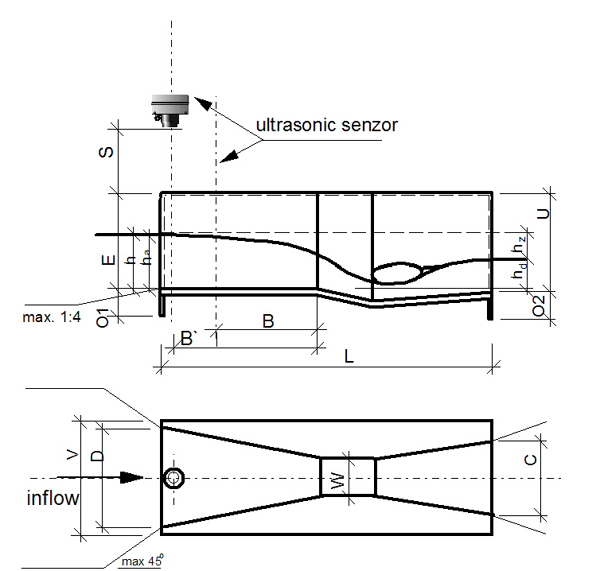Parshall flumes

Product and hydraulic description
The Parshall flume is a flow rate device with a wide range of application. It can be used for flow measurement in creeks, irrigation and/or drainage channels, sewer outfalls, Waste Water Treatment Plants, etc. Main advantages can be summarised as follows:
- A relatively low energy loss (3-4 times lower than in sharp-crested weirs).
- A small sensitivity to a velocity distribution in an approach channel.
- Flow rate measurement even under drowned conditions.
- Velocities inside Parshall flumes are high enough to prevent them from the deposition of sediments or accumulation of debris.
- Minimum maintenance requirements.
- A wide range of flow rates.
- A long lifetime.
Parshall Flume Function
The flow rate measurement is based on the assumption that the critical flow is produced by constricting the width in the throat and then raising the bottom. The flow changes from subcritical to supercritical and then the measurement of a single depth is sufficient to determine the discharge.
The water level is measured and recorded either in the centre line of the approach channel using an ultrasonic level sensor with an electronic unit. The electronic unit transforms the measured flow depth to a flowrate.
Our Parshall flumes can be used with ultrasound or radar sensor and electronic control unit of your choice (supposing the ECU is able to calculate the measuring equation (Q=a*hb).
We produce a range of standard Parshall flumes (P1 to P9) for different Q min and Q max. (Table 1)
The suitable ECU can be offered with our Parshall flume - just please follow legal requirement for ECU in your country and let us know. The ECU and sensors we can offer are CE approved.
Technical data of Parshall flumes
The Parshall flume is made of polypropylene.
The polypropylene is stable within the temperature ranging from -20 to +50 °C.
Precise dimensions and flume weights are shown in Table 1. These dimensions are compulsory for a site design; however, some flume parts and a float manhole can be changed.
Our Parshall flumes have been verified and Type Approved by the Czech Metrology Institute in June 1, 1995 under a certification No TCM 142/95-2075.
A maximum uncertainty of +/- 1.5% of actual flow rate is achieved. Due to a larger uncertainty in the field measuring conditions, we guarantee +/- 3% of actual flow rate.
Legend for Table 1:
- Qmin - minimal flow
- Qmax - maximal flow
- m - hmotnost žlabu (kg)
- A - equation parameter
- B - equation parameter
- B' - distance of sensor from the throat
- U Qmin - expanded uncertainty of measurement
- U Qmax - expanded uncertainty of measurement
- hd/ha - maximal submersion
- M - weight of flume
- W - dimension - width of throat
- C - dimension - width of flume at outlet
- D - dimension - width of flume at inlet
- E - dimension - width of flume (working)
- L - dimension - length of flume
- O2 - dimension
- O1 - dimension
- S - dimension - position of sensor
- U - dimension - height of flume
- V - dimension - width of flume

Operational conditions
The flume is resistant to air temperatures up to 80 °C, however, water inside the flume must not get frozen. Moreover, Parshall flume can stand up well the solutions of inorganic salts, acids and bases that do not exhibit strong oxidation properties, and most of organic solvents. It is recommended to clean the flume and a connecting pipe between the flume and the manhole at least once a year. In flows carrying sediments, it is recommended to carry out the inspection and maintenance more often. Maximum size of suspended solids is limited to 80% of the throat width (dmax = 0,8*W).
Sample Project with Parshall Flumes
Hydraulic Conditions for Parshall Flumes
For correct function of the Parshall flume the conditions of flow in the upstream and downstream are crucial.
On the upstream channel the flow condition must be subcritical state (river flow with Fr < 0,5) while the level must not be swollen up so that the velocity is too slow, and debris can sediment on the ground of the Parshall flume. Streamlines are equally distributed, free of waves and vortexes.
The water on the downstream channel must flow freely out of the flume. The flow shall not back up into the throat of the flume. The level of the water on the downstream must not exceed the submergence ratio given by hd/ha parameter in Table 1.
We can assess your hydraulic design with our Parshall flumes free of charge. Please call us for consultation or send us an email with your project in PDF or DWG format (situation and longitudinal profiles).
Installation Conditions for Parshall Flumes
The Parshall flumes are produced as prefabricated polypropylene products. The installation of Parshall flume is carried out according to the project.
The construction of our Parshall flume allows simple installation by concreting the void spaces around the Parshall flume with simple concrete.
In the manhole there is a space filled with fresh concrete in which the Parshall flume is placed.
The Parshall flumes is installed levelled in the axis of the channel.
Concreting to be done at ambient temperature (+5 to + 20) °C.
When the concrete is ready the bottom of upstream and downstream channel is modelled. And then the sides of upstream and downstream channels are formed to the height of the Parshall flume.
For Parshall flumes P3 and bigger the polypropylene structure is fixed by wooden logs into its position (the inlet section of the Parshall flume has to be levelled).
Vibration of concrete is not done.
Parshall flumes P1, P2 and P3 do no need to be fixed on their insides. Bigger flumes have to be fixed from the inside so that the geometry of the flumes is not affected by concreting.











